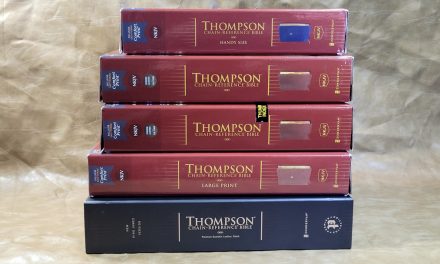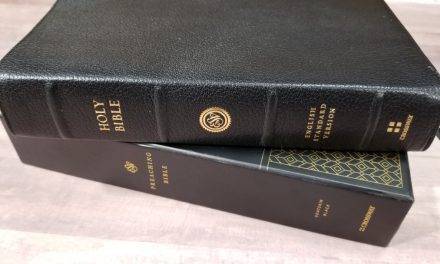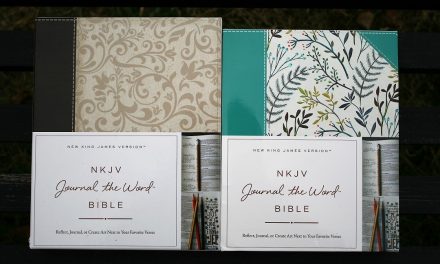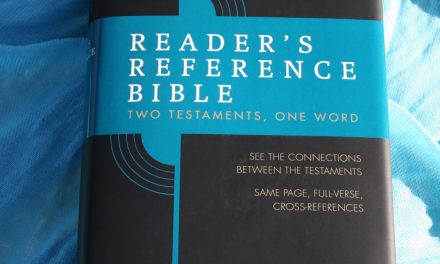The cover of the Bible is a very important feature and should be chosen carefully. I recommend buying the best cover you can afford. A badly made cover will greatly shorten the life of the Bible, while a high quality cover has a better chance of lasting for many years.
Sewn bindings typically last longer than glued and will lay open and flat much easier. Glued bindings tend to keep the spine flat, which makes the text bend into the inner margin. Also, there is a chance the pages will come out with use.
Here is a short glossary of Bible cover and binding terms.
Smyth Sewn – also known as ‘Section Sewn’. This is the highest quality bookbinding available. It is library quality and archival safe. The pages are physically sewn together in sections, known as signatures, using binders thread. The signatures are folded over to make individual sections of the book. The sections are then sewn together, creating the text block. The text block is then glued into the cover using a fabric backing, imitation leather, bonded leather, or real leather.
Goatskin – Goatskin and Highland Goatskin (also known as Real Morocco, or simply Morocco) have a natural grain. Most other leathers have a grain that is stamped onto the leather. Goatskin is very durable and soft.
Calfskin – this is a higher quality leather used for fine bindings. It is usually soft and flexible, which increases with use. Calfskin is one of my favorite leathers.
Calf-split – Calf-split is a higher quality grade than French Morocco. It is tanned to approach the quality and feel of full-grain calfskin. It is stiffer than goatskin and has an elegant feel to the grain.
French Morocco – taken from calfskin. Durable and flexible, though not as soft and flexible as calfskin, it is still a high-quality leather. It is an economical alternative to calfskin.
Cowhide – this is a soft leather that’s more flexible than genuine leather. As its name suggests it’s from cow leather. It is more economical than calfskin and higher quality than genuine leather. It is considered a premium leather.
Genuine Leather – pigskin. This is the cheapest and most popular of real leathers. Covers with genuine leather are usually stiff.
Berkshire – pigskin. Another term for Genuine Leather.
Bonded Leather – left-over leather pieces of pigskin are glued together using glues and resins to form a leather-like cover. My wife calls it ‘chopped ham’. In general, bonded leathers will not last. They tear apart under regular use. Like all leathers, there are various qualities of bonded leather. Cambridge uses 100% real leather fiber.
Imitation Leather – imitation leather is a man-made material that is made to look and feel like leather. There are many variations of imitation leather and they have different names such as TruTone, Kirvella, and Leatherflex. Usually, the higher quality imitation leathers will look and feel soft and be very durable. The cheaper imitation leathers will feel like tough plastic.
Hardcover – hardcover Bibles are made like any other hardcover book. This is one of the most economical covers. Hardcover Bibles are not usually made with the same quality bindings as leather-bound covers. One exception is Cambridge. Cambridge hardcover Bibles are made at a very high standard of quality. If you don’t want to spend $100 or more on a higher quality cover, I recommend Cambridge hardcover Bibles. Just keep in mind their selection of translations is more limited in hardcover. I like hardcover editions because they lay flat and are easier to use.
Paperback – Bibles in paperback are glued. They are useful, but not very good quality. Just don’t expect them to last very long. I don’t know of any wide-margin Bibles in paperback, but there are many study Bibles. I recommend paperback if they are significantly cheaper than the next cover option. Just keep in mind that paperback is the least durable cover available.
Vinyl – vinyl is a more durable and flexible material that paperback and is very inexpensive. Local Church Bible Publishers sells a vinyl version of their better quality Bibles. These Bibles are less than $10 and still of decent quality.
Loose-Leaf – the pages in a loose-leaf Bible are placed into a notebook. This has the benefit of letting you add sheets between the pages, removing the pages for use on the go, etc. Loose-leaf pages have to be of higher quality or they will tear easily. Hendrickson makes a great loose-leaf Bible that is available in several translations.
Lining – the lining is the material on the inside of the cover. It ranges from paper to calfskin leather. Many Bibles use bonded leather or imitation leather for the lining, but there are some Bibles that have real leather. Leather liners will allow the leather cover to be more flexible. More flexibility might be harder to hold in one hand. Paper liners will make the cover feel stiffer, making it easier to hold open in one hand.
Edge Lined – this is the binding style that Allan and Cambridge use in most of their goatskin editions. There is a piece of leather from the liner that is glued between two pages. This takes the stress off of the text block and lasts much longer.
Yapp – this is the leather that goes beyond the edge of the pages. It is available as full Yapp and semi Yapp. A full yapp covers the edges of the paper, offering more protection.
Overcasting – This is vertical stitching that is inserted at the middle of the first and last section to add strength to the binding. Overcasting is mostly found in higher quality sewn Bibles.
Glued binding – this is where the end signatures (the paper that is glued to the spine of the cover) are cut flat and glued to the spine. One major complaint about glued bindings is the Bible will not lay open (except for maybe in the middle of the Bible). I like to open the Bible to Genesis 1:1 and lay it on the table to see if it will stay open. Almost all inexpensive Bibles are glued and will not last as long as sewn bindings.
The featured image is the Cambridge Concord Wide Margin calf-split leather. You can see the review here: Cambridge Concord Wide Margin in Black Calf Split Review












What about lambskin versus calfskin?
Hi Chester. I’ll add this. Thanks!
Hello Randy,
With reference to your “Bible Buying Tip – Cover and Binding” post above and the Trinitarian Bible Society’s KJV Westminster Reference Bible, black calfskin leather edition …
1. What material is being covered by the calfskin leather?
2. What “glue” is being used to secure the said material and the calfskin leather together?
3. Is the under material durable, sufficiently so to last the strength, quality and life-time of calfskin leather?
Thanking you in anticipation of an early reply.
Kind regards,
Toni
Hi Toni. I don’t have the information for 1 and 2. The under material is very durable. I can’t say how long it would last, but Lucinda has used this one since the review and it’s holding up really well.
Many thanks for the prompt reply, Randy!
Toni
Thanks for sharing
What is the most durable and long lasting Bible cover that is available? If you don’t mind, can you give me your top 3? Much appreciated.
Hi Dan. Goatskin, calfskin, and cowhide are my favorites. To last the longest, they need an edge-lined leather liner.
Thanks for sharing.
hi Randy
Greetings from sunny tropical Malaysia! Have been an avid reader of your articles and thank you for the reviews. Was meaning to pick up a KJVER study bible. Have a choice of either the large Giant Print version which is pretty hefty or the smaller Personal Size version. I am veering towards the latter because ironically i find the Giant Print, although visually having a bigger font, somewhat overwhelming (surprisingly). They come in both bonded leather (crocodile walnut) or “leatherlike” covers. Genuine leather is a bit more than what i would pay for. Given the humidity and heat of the tropics, which do you think will be a better choice? I have this perception that bonded leather will start to fray later on but synthetics are also prone to peeling esp in warmer climates. You opinions welcome!
Hi Phil. I’m not sure which would be the better choice. I kind of think neither of them would last very long in that type of climate. The bonded leather might last a touch longer since it does have actual leather.
Thanks for the reply Randy. Took me a while to find this particular webpage again for some odd reason. Decided to pull the trigger on the Giant print genuine leather copy and am glad I did as the larger fonts do help with enabling you to have longer reading sessions. (not to mention some verses popping out at ya more!).
Randy,
Rebinding my family bible. Choices are soft genuine leather and genuine leather. This bible is used every day.
Recommendation?
If it’s a large Bible, I wouldn’t go with a soft leather. I think it would be too difficult to hold.
There are several; trademarked names in use by different publishers. — LeatherTouch, Leathersoft, LeaatherLike, and perhaps others — can you perhaps update the overview (which is excellent), to indicate into which bucket each of these fall into. Thanks
please visit our website, possibly you may want to offer some the process of that makes quality, generational bibles.
843-821-5911 Jennifer Moffa Smyth Machinery 843-821-5911